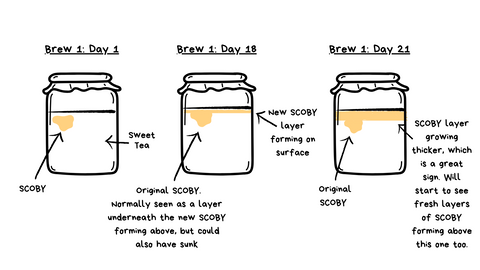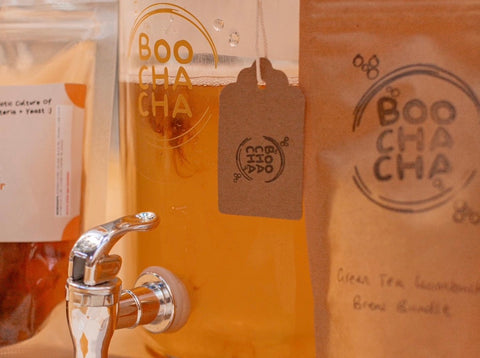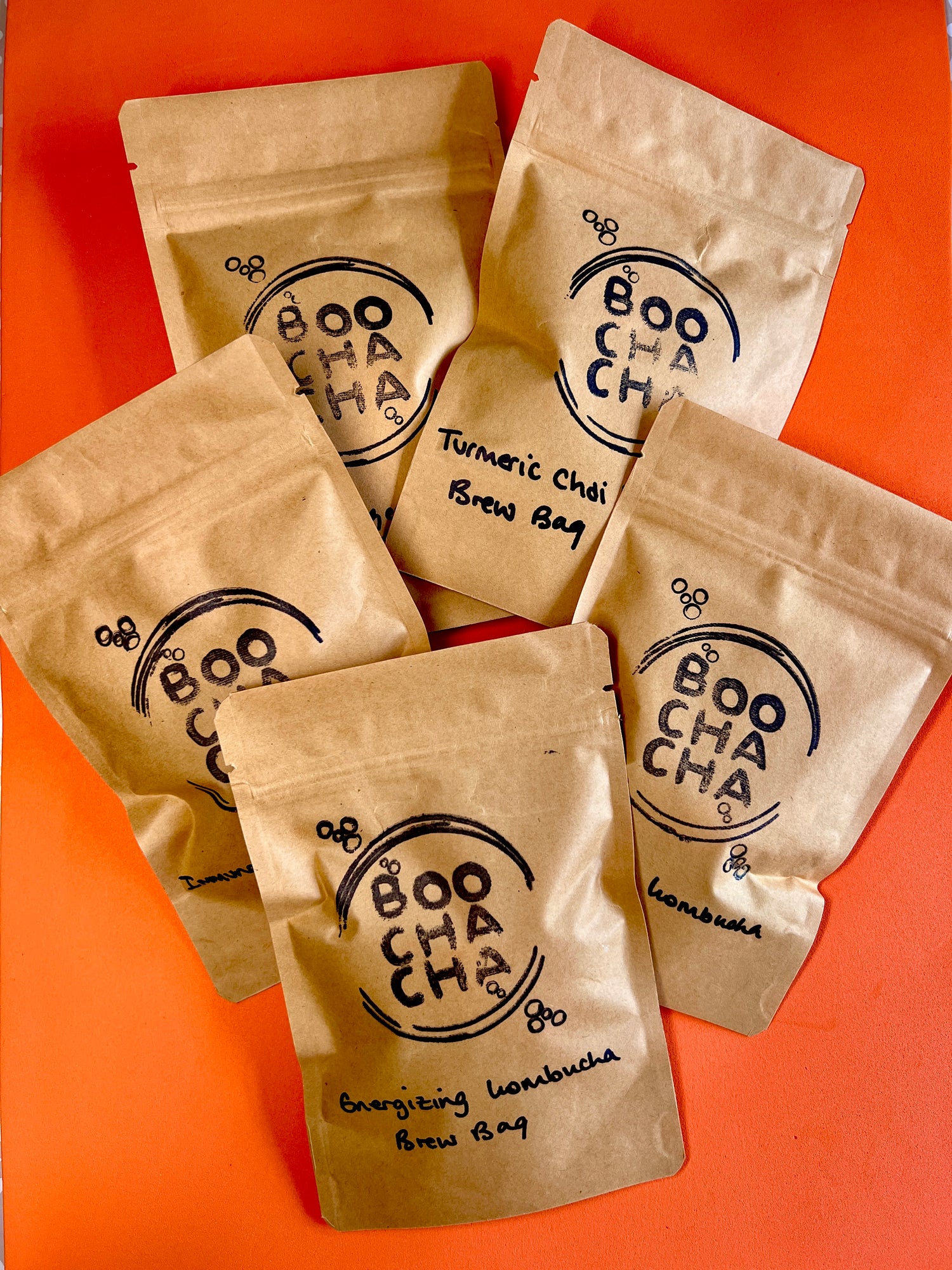A Kombucha SCOBY is a fascinating and complex living organism that plays a crucial role in the production of Kombucha, a fermented tea beverage that has been enjoyed for centuries.
The term “SCOBY” stands for Symbiotic Culture Of Bacteria and Yeast, and it is this symbiotic relationship that allows the SCOBY to transform sweetened tea into a tangy, effervescent drink with potential health benefits.

The Anatomy of a SCOBY
A SCOBY is a rubbery, pancake-like disc that can vary in colour from white to light brown, depending on the types of tea used and the age of the culture. It has a gelatinous texture and may have stringy brown yeast particles hanging from it, which are completely normal and a sign of a healthy fermentation process.
The SCOBY is composed of multiple layers of cellulose, a natural fibre produced by the bacteria in the culture. As the SCOBY ferments the tea, it grows in size and thickness, creating new layers on top of the old ones. This layered structure is not just for show; it’s a testament to the SCOBY’s ongoing life cycle and its ability to reproduce.
The Growth of a SCOBY
The growth of a SCOBY is a fascinating process that occurs during the fermentation of kombucha. When you first start a batch of kombucha, you’ll add A SCOBY to a mixture of sweet tea. The yeast in the SCOBY begins to consume the sugar, converting it into alcohol and carbon dioxide, which gives kombucha its characteristic fizz.
Meanwhile, the bacteria in the SCOBY feed on the alcohol produced by the yeast, converting it into acetic acid and other organic acids. This acid production is what gives kombucha its famous tarty taste and keeps the pH of the liquid low enough to be inhospitable to harmful microorganisms and hence preserving it naturally.
As the fermentation process continues, the SCOBY grows by producing new layers of cellulose. These layers can be seen as thin films forming on the surface of the kombucha. Over time, these films thicken and merge to become part of the main SCOBY body. This growth can be influenced by several factors, including the temperature of the environment, the nutrients available in the tea, and the duration of the fermentation.
We always encourage our customers to be really patient with their first kombucha brew, as this is the most important one to get that good strong SCOBY forming. If you're patient enough with your first brew, and keep the temperature about 22 degrees Celcius, you should form a good solid SCOBY layer over the top of the liquid. This means, that your subsequent brews will ferment much faster, and they'll develop a light effervescent fizz because the carbon dioxide produced during fermentation will be trapped in the liquid. This is the most important step in setting up a continuous Kombucha brew at home, and getting it right will guarantee you a lifetime of kombucha brewing happiness.
The image below shows the time-line of SCOBY growth.

Reproduction and Propagation
One of the most remarkable aspects of a SCOBY is its ability to reproduce. As the SCOBY grows, it creates new layers that can be separated from the parent culture. These layers, often referred to as “baby SCOBYs,” can be used to start new batches of kombucha, shared with friends, or stored as backups.
To propagate a new SCOBY, simply peel off one of the layers from the parent SCOBY and place it in a new jar with some of the original kombucha liquid and fresh sweetened tea. The baby SCOBY will then begin the fermentation process, creating a new batch of kombucha and continuing the cycle of growth.
Caring for Your SCOBY
Maintaining a healthy SCOBY is essential for successful kombucha brewing. It’s important to keep the SCOBY in a clean environment and to handle it with clean hands or utensils to prevent contamination. The SCOBY should be stored in a glass jar with enough kombucha liquid to keep it moist and fed between batches.
The temperature of the storage area should be kept consistent, ideally between 22-29 degrees Celsius, to promote steady growth and fermentation. If the temperature is too low, the SCOBY’s growth will slow down, and the fermentation process may take longer. If it’s too high, the SCOBY can become stressed, leading to an imbalance in the bacteria and yeast populations.

The SCOBY’s Ecosystem
The SCOBY is more than just a cellulose structure; it’s a thriving ecosystem of various bacteria and yeast strains that work together in harmony. The specific composition of a SCOBY can vary depending on its origin and the environment in which it’s grown, but common bacteria include Gluconacetobacter xylinus, which is responsible for producing cellulose, and Acetobacter, which helps convert alcohol into acetic acid.
The yeast component of the SCOBY typically includes strains such as Saccharomyces and Brettanomyces, which are responsible for initiating the fermentation process by breaking down sugar into alcohol and carbon dioxide.
The SCOBY’s Role in Kombucha Flavour
The SCOBY’s impact on the flavour of kombucha cannot be overstated. The balance of bacteria and yeast within the SCOBY determines the final taste profile of the kombucha. A healthy SCOBY will produce a well-balanced kombucha with a pleasant mix of sweetness and acidity, along with the subtle flavours of the tea used in the brewing process.
As the SCOBY ages and continues to ferment batch after batch of kombucha, the flavour of the resulting beverage may evolve. Some brewers prefer the taste of kombucha made with a mature SCOBY, while others may choose to start with a new SCOBY periodically to maintain a consistent flavour.
Making kombucha at home allows you to experiment with flavours and find the perfect one for you, whilst being sure there are no added nasties, or sneaky filtration processes which increase the shelf life, but remove the goodness.

The Lifespan of a SCOBY
A well-cared-for SCOBY can last for many years and produce countless batches of kombucha. However, over time, a SCOBY may become too thick, which can slow down the fermentation process.
When this happens, it’s a good idea to peel off some of the older layers from the bottom of the SCOBY and either compost them or use them for other purposes, such as making SCOBY snacks or using them in skincare routines.
Conclusion
The kombucha SCOBY is a remarkable and dynamic organism that is at the heart of the kombucha brewing process. Its ability to grow, reproduce, and transform sweet tea into a flavourful, fizzy beverage is a testament to the power of fermentation.
By understanding the SCOBY and how it grows, kombucha brewers can better care for their cultures and produce delicious, healthful kombucha for themselves and their communities. Whether you’re a seasoned brewer or a curious newcomer, the world of the SCOBY is an endlessly fascinating one that offers a unique blend of science, art, and health.
Check out our own SCOBY gallery here, and if you’re now looking for the best Kombucha Starter Kit then check out our range of DIY Kombucha Starter Kits here, we are rated 5 stars over and over again, especially by Kombucha brewing beginners 😇


